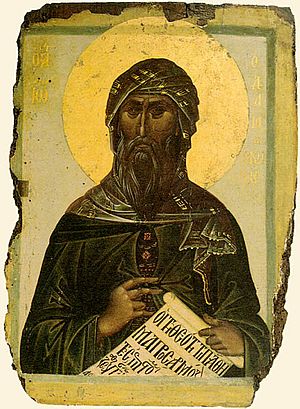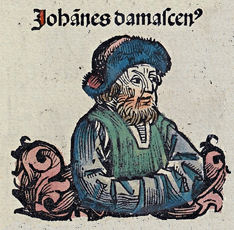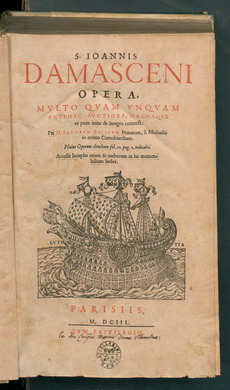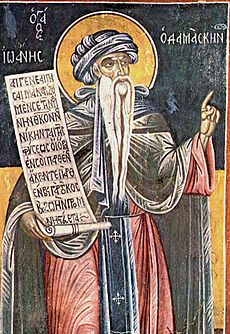John of Damascus facts for kids
Quick facts for kids SaintJohn of Damascus يوحنا الدمشقي |
|
|---|---|

Greek icon (14th century)
|
|
| Doctor of the Church, Monk, Teacher of the Faith |
|
| Born | c. 675 or 676 Damascus, Bilad al-Sham, Umayyad Caliphate |
| Died | 4 December 749 Mar Saba, Jerusalem, Bilad al-Sham, Umayyad Caliphate |
| Venerated in | Catholic Church Eastern Orthodox Church Anglican Communion Commemorated in Lutheranism |
| Canonized | Pre-congregation |
| Feast | 4 December 27 March (General Roman Calendar, 1890–1969) |
| Attributes | Severed hand, icon |
| Patronage | Pharmacists, icon painters, theology students
Philosophy career |
|
Notable work
|
Philosophical chapters An Exact Exposition of the Orthodox Faith Concerning heresy |
| Era | Medieval philosophy Byzantine philosophy |
| School | Neoplatonism |
|
Main interests
|
Law, Christian theology, Philosophy, Apologetics, Criticism of Islam, Geometry, Mariology, Arithmetic, Astronomy, and Music |
|
Notable ideas
|
Icon, Dormition/Assumption of Mary, Theotokos, Perpetual virginity of Mary, Mediatrix |
|
Influences
|
|
|
Influenced
|
|
John of Damascus (born Manṣūr ibn Sarjūn) was an important Christian monk, priest, hymn writer, and defender of the faith. He was born in Damascus around 675 or 676. He died around December 4, 749, likely at his monastery, Mar Saba, near Jerusalem.
John was very knowledgeable in many areas, including law, theology, philosophy, and music. People called him Chrysorroas, which means "streaming with gold" or "the golden speaker," because of his excellent speaking and writing skills.
He wrote many works explaining Christian beliefs. He also composed hymns that are still sung today in Eastern Christian churches and in some Western churches.
John is considered one of the important leaders of the Eastern Orthodox Church. He is especially famous for strongly defending the use of icons (religious images). The Catholic Church also honors him as a Doctor of the Church. He is sometimes called the Doctor of the Assumption because of his writings about the Assumption of Mary.
Most of what we know about John of Damascus comes from a biography written by someone named John of Jerusalem. This biography was first written in Arabic and then translated into Greek. It was written to honor him, so it might include some exaggerated or legendary stories.
Contents
Family and Early Life
John was born in Damascus to a well-known Christian Arab family. His father, Sarjun ibn Mansur, worked for the early Umayyad Caliphate, which was a large Islamic empire. His grandfather, Mansur ibn Sarjun, was also an important official in Damascus. He managed taxes for the Byzantine Empire and later for the Muslim rulers.
When the Muslim Arabs took over Syria in the 630s, many Christian officials, like John's grandfather, continued to work for the new government. John's father, Sarjun, also served the Umayyad leaders. Some stories say that John himself worked for the Caliph's court before he became a monk. However, Muslim records mention his father but not John working in the court. Also, John's own writings do not mention this.
Becoming a Monk and Priest
John grew up in Damascus. Some stories say he was friends with Yazid I, who later became a Caliph. He also knew a Christian poet named al-Akhtal.
John's father wanted him to learn both Muslim and Greek books. This suggests John might have grown up speaking two languages. John's writings show he knew about the Quran, which he sometimes criticized.
He received a good education in Damascus, learning about Greek culture and Christian teachings. His teacher was a monk named Cosmas the Monk, who had been kidnapped from Sicily. John's father paid a lot to free Cosmas. Under Cosmas's teaching, John became very skilled in music, astronomy, and theology.
John later left his life in Damascus to become a monk at the Mar Saba monastery near Jerusalem. He was ordained as a priest around 735.
Defending Holy Images
In the early 700s, a movement called iconoclasm started in the Byzantine Empire. This movement was against showing or honoring icons (religious images). In 726, Emperor Leo III ordered that images should not be displayed in public.
John of Damascus strongly defended the use of holy images in three important writings. His first work, Apologetic Treatises against those Decrying the Holy Images, made him famous. He not only argued against the emperor but also wrote in a simple way so that ordinary people could understand the debate. Many years after his death, John's writings were very important at the Second Council of Nicaea in 787. This council met to settle the argument over icons.
One famous story about John says that Emperor Leo III sent fake documents to the Caliph. These documents made it seem like John was plotting to attack Damascus. The Caliph then ordered John's right hand to be cut off. The story says that John prayed to the Theotokos (Mother of God) in front of her icon, and his hand was miraculously healed. To show his thanks, he put a silver hand on the icon. This icon became known as the "Three-handed" or Tricheirousa. It is now in the Hilandar monastery.
Honors and Recognition
John of Damascus is honored on December 4 in the General Roman Calendar, the Byzantine Rite calendar, and by some Lutheran and Anglican churches. This date is believed to be the day he died.
In 1890, Pope Leo XIII declared him a Doctor of the Church. This title is given to saints whose writings and teachings are especially important for the Church.
Important Writings
Besides his written works, John of Damascus also wrote many hymns. He helped to perfect the canon, which is a structured hymn used in Byzantine church services.
Early Works
- Three Apologetic Treatises against those Decrying the Holy Images – These were his first writings defending holy images against Emperor Leo III's ban.
Teachings and Dogmatic Works
- Fountain of Knowledge or The Fountain of Wisdom – This large work is divided into three parts:
- Philosophical Chapters – This part, also called "Dialectic," focuses on logic. It was meant to help readers understand the rest of the book better.
- Concerning Heresy – The last chapter of this part (Chapter 101) talks about "the Heresy of the Ishmaelites," which is how he referred to Islam. This chapter is much longer than those about other heresies and is one of the first Christian criticisms of Islam.
- An Exact Exposition of the Orthodox Faith – This part summarizes the teachings of early Church leaders. It was the first systematic theology (organized study of religious beliefs) in Eastern Christianity and greatly influenced later Christian thought.
- Against the Jacobites
- Against the Nestorians
- Dialogue against the Manichees
- Elementary Introduction into Dogmas
- Letter on the Thrice-Holy Hymn
- On Right Thinking
- On the Faith, Against the Nestorians
- On the Two Wills in Christ (Against the Monothelites)
- Octoechos (a church book of eight tones for hymns)
His Views on Islam
In his work Concerning Heresy, John of Damascus discussed Islam, calling it "the Heresy of the Ishmaelites." He was one of the first Christian writers to criticize Islam.
John claimed that Muslims used to worship a goddess named Aphrodite. He also suggested that the Prophet Mohammad read the Bible and learned from an Arian monk, who taught him a different form of Christianity. John also said he had read parts of the Quran. He criticized it for saying that the Virgin Mary was the sister of Moses and Aaron, and that Jesus was not crucified but went to heaven alive.
John claimed he spoke with Muslims about Mohammad. He asked them what witnesses could prove that Mohammad received the Quran from God. He pointed out that Moses received the Torah from God in front of the Israelites. He also asked what prophets in the Bible foretold Mohammad's coming, as Jesus was foretold. John said the Muslims replied that Mohammad received the Quran in his sleep. John joked, "You're spinning my dreams."
Some Muslims, he said, claimed that Christians misunderstood the Old Testament prophecies about Jesus. Others said that Jews changed the Old Testament to trick Christians.
John also claimed that Muslims accused him of idol worship for honoring the Cross and worshipping Jesus. He said he told them that the black stone in Mecca was once the head of a statue of Aphrodite. He also argued that if Jesus is the Word of God, and the Word has always been with God, then Jesus must be part of God and therefore God himself.
John ended his discussion by saying that Islam allows polygamy (having more than one spouse) and that the Quran has strange stories, like the She-Camel of God.
Arabic Translations of His Works
It is believed that one of John's sermons was the first of his works to be translated into Arabic. This translation dates back to 885 AD.
Later, in the 10th century, a monk named Antony translated many of John's works into Arabic. In 1085, another monk, Mikhael, wrote an Arabic biography of John.
Modern English Translations
Many of John of Damascus's writings have been translated into English. These translations help people today study his important ideas and learn about his life. Some of his translated works include:
- On holy images; followed by three sermons on the Assumption
- Exposition of the Orthodox faith
- Writings (including The fount of knowledge; On heresies; The orthodox faith)
- John of Damascus on Islam: The "Heresy of the Ishmaelites"
- On the divine images: the apologies against those who attack the divine images
- Three Treatises on the Divine Images
See also
 In Spanish: Juan Damasceno para niños
In Spanish: Juan Damasceno para niños




